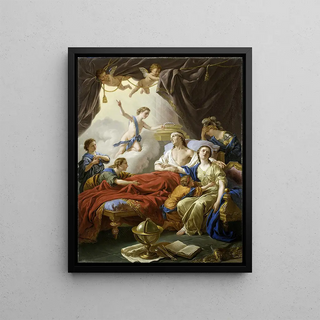Art print | Allegory on the death of the Dauphin - Louis-Jean-François Lagrenée


View from behind

Frame (optional)
Allégorie on the death of the Dauphin - Louis-Jean-François Lagrenée – Captivating introduction
In the rich and complex universe of art history, certain works stand out for their ability to evoke deep emotions and stimulate reflection. "Allégorie sur la mort du Dauphin" by Louis-Jean-François Lagrenée is one such piece that, beyond its formal beauty, invites contemplation on mortality and the passage of time. Painted in the 18th century, this work is set within a historical context where art reflects societal and philosophical concerns of its time. Lagrenée, using powerful symbols and evocative visual language, manages to capture the very essence of human tragedy, making this piece essential for anyone interested in the alliance between art and existential reflection.
Style and uniqueness of the work
Lagrenée's style is characterized by impressive technical mastery and an aesthetic sensitivity unique to him. In "Allégorie sur la mort du Dauphin," the artist skillfully plays with light and shadow, creating striking contrasts that enhance the emotions felt by the depicted figures. The colors, carefully chosen, harmonize to evoke both melancholy and beauty, while the poses of the characters demonstrate great expressiveness. Every detail, from the drapery of the clothing to the facial expressions, contributes to the visual storytelling of the piece. Lagrenée thus succeeds in giving life to a scene that, although tragic, is imbued with undeniable grace, making this work a true allegory of the fleeting beauty of life.
The artist and his influence
Louis-Jean-François Lagrenée, an emblematic figure of the 18th century, is often recognized for his role in the development of neoclassical art in France. Trained in François Boucher's workshop, he was able to incorporate rococo influences while transcending them through a more rigorous and intellectual approach to art. His work is marked by a quest for formal perfection and a desire to explore universal themes, such as death and beauty. Lagrenée was also a

Matte finish

View from behind

Frame (optional)
Allégorie on the death of the Dauphin - Louis-Jean-François Lagrenée – Captivating introduction
In the rich and complex universe of art history, certain works stand out for their ability to evoke deep emotions and stimulate reflection. "Allégorie sur la mort du Dauphin" by Louis-Jean-François Lagrenée is one such piece that, beyond its formal beauty, invites contemplation on mortality and the passage of time. Painted in the 18th century, this work is set within a historical context where art reflects societal and philosophical concerns of its time. Lagrenée, using powerful symbols and evocative visual language, manages to capture the very essence of human tragedy, making this piece essential for anyone interested in the alliance between art and existential reflection.
Style and uniqueness of the work
Lagrenée's style is characterized by impressive technical mastery and an aesthetic sensitivity unique to him. In "Allégorie sur la mort du Dauphin," the artist skillfully plays with light and shadow, creating striking contrasts that enhance the emotions felt by the depicted figures. The colors, carefully chosen, harmonize to evoke both melancholy and beauty, while the poses of the characters demonstrate great expressiveness. Every detail, from the drapery of the clothing to the facial expressions, contributes to the visual storytelling of the piece. Lagrenée thus succeeds in giving life to a scene that, although tragic, is imbued with undeniable grace, making this work a true allegory of the fleeting beauty of life.
The artist and his influence
Louis-Jean-François Lagrenée, an emblematic figure of the 18th century, is often recognized for his role in the development of neoclassical art in France. Trained in François Boucher's workshop, he was able to incorporate rococo influences while transcending them through a more rigorous and intellectual approach to art. His work is marked by a quest for formal perfection and a desire to explore universal themes, such as death and beauty. Lagrenée was also a






